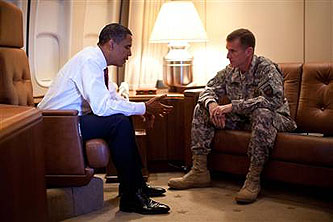 So what kind of options is President Obama getting from his military commanders regarding Afghanistan? Here’s Martha Raddatz of ABC News on the advice he’s getting from Gen. Stanley McChrystal:
So what kind of options is President Obama getting from his military commanders regarding Afghanistan? Here’s Martha Raddatz of ABC News on the advice he’s getting from Gen. Stanley McChrystal:
The three options are, option one: send no more troops to Afghanistan, considered a “high risk option;” option two: send 40,000 more troops, and option three: a major increase in troops, a number that has not been made public but that is far more than 40,000….We’re told that number is […] well more than 60,000, but under 100,000. But this high option is not the one McChrystal favors. He favors the middle option.
And here’s the New York Times:
Officials said over the weekend that Gen. Stanley A. McChrystal, the top NATO commander in Afghanistan, had prepared options that include a maximum troop increase of about 80,000, a number highly unlikely to be considered seriously by the White House. Much of the official focus has been on a lower option that the general presented, for 40,000 additional troops.
A couple of months ago Rajiv Chandrasekaran wrote a piece in the Washington Post about the post-Petraeus Pentagon’s focus on “a new kind of military leader,” one who was “able to nimbly run the troops on the ground as well as the traps in Washington.” Stanley McChrystal was said to be just such a leader.
And apparently he is. Nobody takes the 80,000 number seriously, and McChrystal certainly knew that would be the case. Apparently he didn’t even endorse it himself. So why include it? All part of nimbly running the traps in Washington, I imagine. If you toss in a higher number, then the natural compromise figure becomes 40,000, the place he wanted to be all along. It’s one thing for Obama to eventually decide on a figure a little lower than the high-end option, but once everything has been properly leaked it’s a lot harder for him to publicly defend a figure that’s less than even McChrystal’s pre-packaged “compromise” position.
This is all pretty obvious stuff and I don’t want to make too much out of it. But I’ll repeat something I said earlier anyway: I’m not really thrilled at the idea of the Pentagon focusing its energies on promoting generals who are good Washington gameplayers. If McChrystal truly doesn’t favor the higher option, we’d all be better off if he just left it out and instead made the recommendation he really believes in. Trying to box in the commander-in-chief may be business as usual when it comes to things like F-22 acquisitions or base closings, but I don’t have to like it. I especially don’t have to like it when it comes to things a little more important than Lockheed-Martin’s balance sheet. And I don’t.















